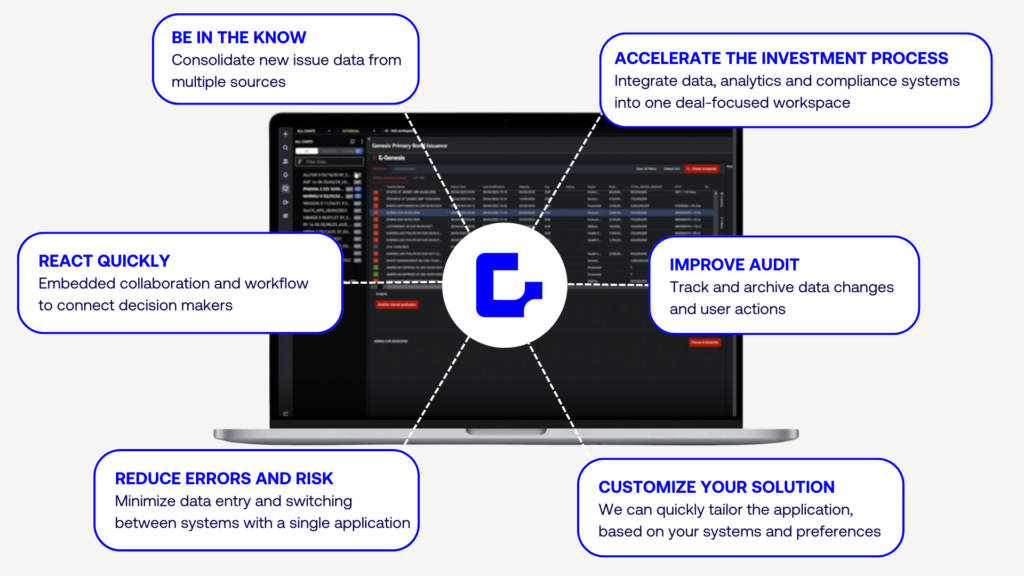Blog
Ending Technology Asymmetry in Primary Markets for Bonds
Originally published by Finextra and Trader Magazine
Accessing the primary market for corporate bonds can be lucrative for asset managers astute about pricing and credit quality. However, surveilling the market, managing data on new issues and making investment decisions quickly enough are challenges for most buyside institutions. In contrast, on the sell side of the new issue market, syndicating banks have invested in technology for over 10 years to help them automate the book building process and reconcile the data they require for accurately processing client orders with tools like Ipreo (now part of S&P Global), DirectBooks, as well as traditional dealer-to-client networks like Bloomberg and Refinitiv.
With only a couple of hours to decide whether to purchase new issues, ending this technology asymmetry should be a priority for asset managers seeking to maximize their effectiveness in primary markets for bonds. Genesis offers a customizable application that aggregates data, integrates trade-related systems and facilitates collaboration to help the asset manager monitor the new issue market, evaluate opportunities and coordinate decision making between portfolio managers, credit analysts and traders.

Centralizing and enriching deal data
Operating effectively in primary markets begins with surveillance and having confidence that the firm not only sees all the deals that come to market but also tracks key changes and updates to deal terms. While syndication tools like Ipreo have made some aspects of deal monitoring easier for asset managers, deal data are still transmitted through several platforms. Moreover, different platforms can publish data at different times, making updates asynchronous and it’s not uncommon for 30 or more changes in terms to be communicated within the two- to four-hour window asset managers are provided to decide and transmit their level of interest in the deal. Firms are under pressure to decide quickly about each deal and managing the data is a key hurdle.
Centralizing new issue data is the core of the solution. Beyond consolidating data from the multiple channels used by syndicating banks, a central solution can also normalize deal data, based on the asset manager’s preferences, overcoming the challenge of multiple data formats and conventions in the market today. The system can reconcile differences in issuer name, identifiers used, field labels for key terms like call dates, maturity, currency, etc., presenting the user with a customized, standardized environment for deals data. In addition, aggregating deal data can compensate for incomplete data arriving from different sources. When a new issue is broadcast over two or more networks, the central system can consolidate information and present the most comprehensive view possible, creating a golden file from multiple inputs.
Success, then, is more than data aggregation, it’s data enrichment.
Intelligent market monitoring
With new issue data centralized, asset managers can incorporate a range of screening tools to filter data and deliver only relevant information to portfolio managers, credit analysts and traders. For updates to deal terms, the system can filter for only the terms that have changed and update the master deal view accordingly. Depending on the portfolio strategy, screening tools can allow users to specify the deals they want to consider, based on size, rating, currency, industry, ESG factors, etc. This helps asset managers focus on what’s important to them amid a torrent of noise in the market.
Unifying deal workflow
Centralizing new issue data creates the opportunity to integrate a range of analytics and trade workflow into the deal environment to accelerate decision making. With one workspace for data, analytics and trading, investment teams can see everything in one place and no time is lost going from one system to another, entering data and, potentially, creating errors and risk. For example, connecting to the asset manager’s internal analytics engine brings together deal and issuer data and new issue curves can be generated using internal data combined with what’s being communicated by the syndicate.
Similarly, integrating with trade and compliance systems can streamline how orders are created, reducing manual entry and the potential for errors. In creating orders, fields can be autofilled from the centralized data and compliance checks can be completed automatically. After orders are communicated to the bookrunners, allocation data can flow into both the EMS and the new issue management system accessible to the entire investment team.
Collaboration and audit
With data, analytics and trade workflow tools unified in one system, embedding workflow and collaboration tools like Symphony or Teams is the final element of speeding up investment decision making involving portfolio managers, credit analysts and traders. Via a central system, handoffs can happen automatically and alerts can be generated to trigger further actions, reviews and approvals, maximizing the efficiency achieved by investment teams. Communication can be embedded throughout the workflow, keeping the data, discussion and decision making history together in one, auditable environment, that facilitates speed and compliance.
Automation on the sell side has raised the stakes for investment firms seeking opportunities in the primary markets for corporate bonds. With only a few short hours to make decisions before syndicate books are closed, centralizing data and connecting systems into a unified environment presents a valuable opportunity for asset managers to design a technology solution to create not only efficiency, but competitive advantage through better market surveillance, deal selection and speed to request allocations.
The best investment you’ll ever make
Learn more about our customizable application for primary bond markets.
Learn More